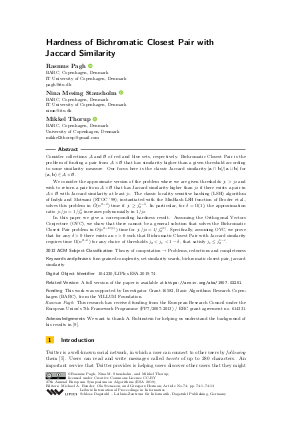Hardness of Bichromatic Closest Pair with Jaccard Similarity
Authors
Rasmus Pagh  ,
Nina Mesing Stausholm
,
Nina Mesing Stausholm  ,
Mikkel Thorup
,
Mikkel Thorup 
-
Part of:
Volume:
27th Annual European Symposium on Algorithms (ESA 2019)
Part of: Series: Leibniz International Proceedings in Informatics (LIPIcs)
Part of: Conference: European Symposium on Algorithms (ESA) - License:
 Creative Commons Attribution 3.0 Unported license
Creative Commons Attribution 3.0 Unported license
- Publication Date: 2019-09-06
File

PDF
LIPIcs.ESA.2019.74.pdf
- Filesize: 0.5 MB
- 13 pages
Document Identifiers
Related Versions
-
A full version of the paper is available at https://arxiv.org/abs/1907.02251.
Subject Classification
ACM Subject Classification
- Theory of computation → Problems, reductions and completeness
Keywords
- fine-grained complexity
- set similarity search
- bichromatic closest pair
- jaccard similarity
Metrics
- Access Statistics
-
Total Accesses (updated on a weekly basis)
0PDF Downloads0Metadata Views
Abstract
Consider collections A and B of red and blue sets, respectively. Bichromatic Closest Pair is the problem of finding a pair from A x B that has similarity higher than a given threshold according to some similarity measure. Our focus here is the classic Jaccard similarity |a cap b|/|a cup b| for (a,b) in A x B. We consider the approximate version of the problem where we are given thresholds j_1 > j_2 and wish to return a pair from A x B that has Jaccard similarity higher than j_2 if there exists a pair in A x B with Jaccard similarity at least j_1. The classic locality sensitive hashing (LSH) algorithm of Indyk and Motwani (STOC '98), instantiated with the MinHash LSH function of Broder et al., solves this problem in Õ(n^(2-delta)) time if j_1 >= j_2^(1-delta). In particular, for delta=Omega(1), the approximation ratio j_1/j_2 = 1/j_2^delta increases polynomially in 1/j_2. In this paper we give a corresponding hardness result. Assuming the Orthogonal Vectors Conjecture (OVC), we show that there cannot be a general solution that solves the Bichromatic Closest Pair problem in O(n^(2-Omega(1))) time for j_1/j_2 = 1/j_2^o(1). Specifically, assuming OVC, we prove that for any delta>0 there exists an epsilon>0 such that Bichromatic Closest Pair with Jaccard similarity requires time Omega(n^(2-delta)) for any choice of thresholds j_2 < j_1 < 1-delta, that satisfy j_1 <= j_2^(1-epsilon).
Cite As Get BibTex
Rasmus Pagh, Nina Mesing Stausholm, and Mikkel Thorup. Hardness of Bichromatic Closest Pair with Jaccard Similarity. In 27th Annual European Symposium on Algorithms (ESA 2019). Leibniz International Proceedings in Informatics (LIPIcs), Volume 144, pp. 74:1-74:13, Schloss Dagstuhl – Leibniz-Zentrum für Informatik (2019)
https://doi.org/10.4230/LIPIcs.ESA.2019.74
BibTex
@InProceedings{pagh_et_al:LIPIcs.ESA.2019.74,
author = {Pagh, Rasmus and Stausholm, Nina Mesing and Thorup, Mikkel},
title = {{Hardness of Bichromatic Closest Pair with Jaccard Similarity}},
booktitle = {27th Annual European Symposium on Algorithms (ESA 2019)},
pages = {74:1--74:13},
series = {Leibniz International Proceedings in Informatics (LIPIcs)},
ISBN = {978-3-95977-124-5},
ISSN = {1868-8969},
year = {2019},
volume = {144},
editor = {Bender, Michael A. and Svensson, Ola and Herman, Grzegorz},
publisher = {Schloss Dagstuhl -- Leibniz-Zentrum f{\"u}r Informatik},
address = {Dagstuhl, Germany},
URL = {https://drops.dagstuhl.de/entities/document/10.4230/LIPIcs.ESA.2019.74},
URN = {urn:nbn:de:0030-drops-111951},
doi = {10.4230/LIPIcs.ESA.2019.74},
annote = {Keywords: fine-grained complexity, set similarity search, bichromatic closest pair, jaccard similarity}
}
Author Details
Funding
This work was supported by Investigator Grant 16582, Basic Algorithms Research Copenhagen (BARC), from the VILLUM Foundation.
- Pagh, Rasmus: This research has received funding from the European Research Council under the European Union’s 7th Framework Programme (FP7/2007-2013) / ERC grant agreement no. 614331.
Acknowledgements
We want to thank A. Rubinstein for helping us understand the background of his results in [Aviad Rubinstein, 2018].
References
-
Andrei Z Broder. On the resemblance and containment of documents. In Compression and complexity of sequences 1997. proceedings, pages 21-29. IEEE, 1997.

- Lijie Chen. On The Hardness of Approximate and Exact (Bichromatic) Maximum Inner Product. In 33rd Computational Complexity Conference, CCC 2018, June 22-24, 2018, San Diego, CA, USA, pages 14:1-14:45, 2018. URL: https://doi.org/10.4230/LIPIcs.CCC.2018.14.
- Lijie Chen and Ryan Williams. An Equivalence Class for Orthogonal Vectors. In Proceedings of the Thirtieth Annual ACM-SIAM Symposium on Discrete Algorithms, SODA 2019, San Diego, California, USA, January 6-9, 2019, pages 21-40, 2019. URL: https://doi.org/10.1137/1.9781611975482.2.
- Tobias Christiani and Rasmus Pagh. Set similarity search beyond MinHash. In Proceedings of the 49th Annual ACM SIGACT Symposium on Theory of Computing, STOC 2017, Montreal, QC, Canada, June 19-23, 2017, pages 1094-1107, 2017. URL: https://doi.org/10.1145/3055399.3055443.
-
Ashish Goel, Aneesh Sharma, Dong Wang, and Zhijun Yin. Discovering similar users on twitter. In 11th Workshop on Mining and Learning with Graphs, 2013.

- Pankaj Gupta, Ashish Goel, Jimmy J. Lin, Aneesh Sharma, Dong Wang, and Reza Zadeh. WTF: the who to follow service at twitter. In 22nd International World Wide Web Conference, WWW '13, Rio de Janeiro, Brazil, May 13-17, 2013, pages 505-514, 2013. URL: https://doi.org/10.1145/2488388.2488433.
- Piotr Indyk and Rajeev Motwani. Approximate Nearest Neighbors: Towards Removing the Curse of Dimensionality. In Proceedings of the Thirtieth Annual ACM Symposium on the Theory of Computing, Dallas, Texas, USA, May 23-26, 1998, pages 604-613, 1998. URL: https://doi.org/10.1145/276698.276876.
- Rasmus Pagh, Nina Stausholm, and Mikkel Thorup. Hardness of Bichromatic Closest Pair with Jaccard Similarity, 2019. URL: http://arxiv.org/abs/1907.02251.
- Aviad Rubinstein. Hardness of approximate nearest neighbor search. In Proceedings of the 50th Annual ACM SIGACT Symposium on Theory of Computing, STOC 2018, Los Angeles, CA, USA, June 25-29, 2018, pages 1260-1268, 2018. URL: https://doi.org/10.1145/3188745.3188916.
- Gregory Valiant. Finding Correlations in Subquadratic Time, with Applications to Learning Parities and the Closest Pair Problem. J. ACM, 62(2):13:1-13:45, 2015. URL: https://doi.org/10.1145/2728167.
- Virginia Vassilevska Williams. Some Open Problems in Fine-Grained Complexity. SIGACT News, 49(4):29-35, 2018. URL: https://doi.org/10.1145/3300150.3300158.
